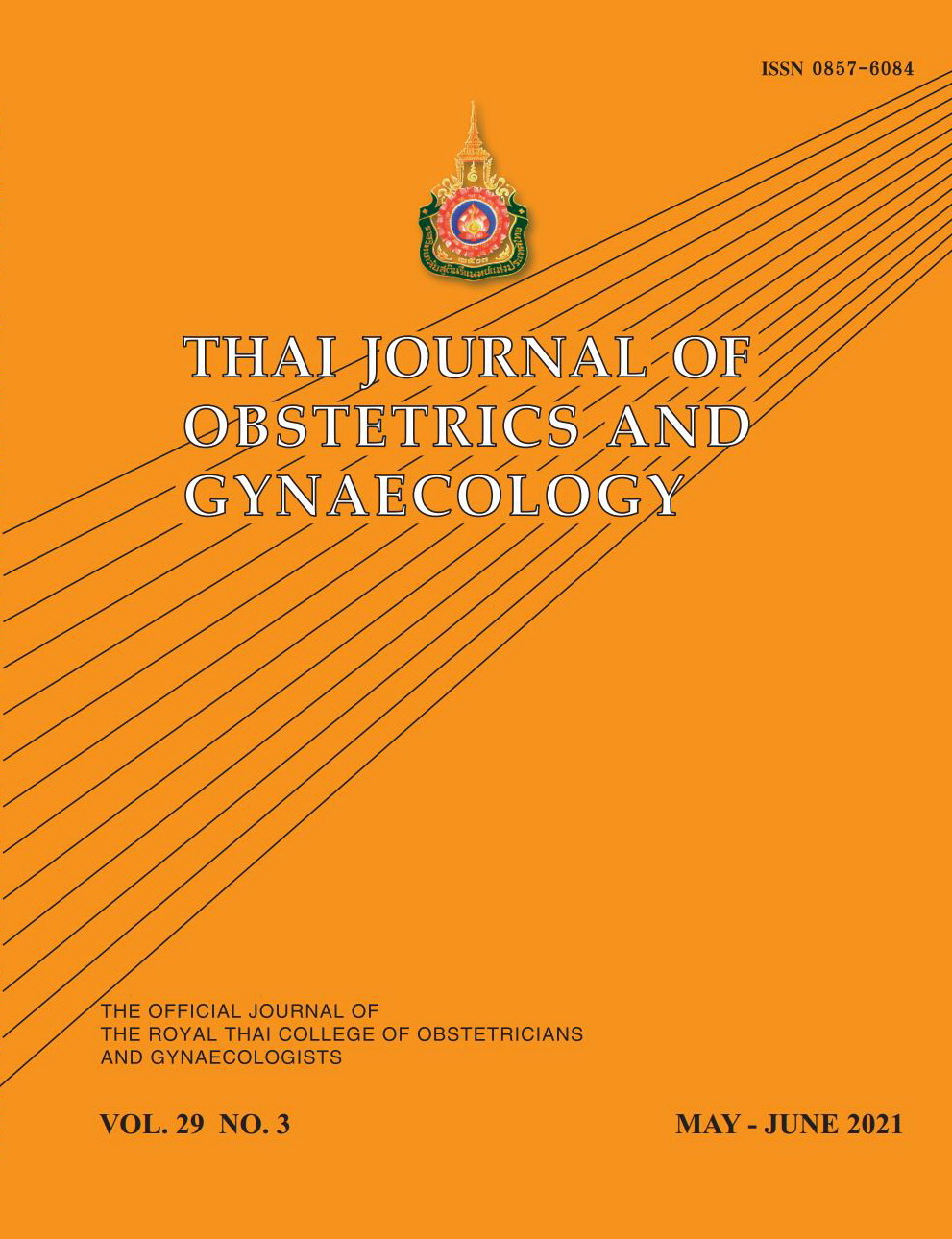Diagnostic Indices of Intraoperative Gross Assessment in the Surgical Staging of Endometrial Cancer
Main Article Content
Abstract
Objectives: To determine the diagnostic indices of intraoperative gross assessment in the surgical staging of endometrial cancer.
Materials and Methods: We retrospectively reviewed medical records and operative notes of a total of 112 patients who were diagnosed with endometrial cancer in Prapokklao Hospital between 2014 and 2019. We aimed to determine the diagnostic indices of gross visual inspection compared with the final pathological reports. Diagnostic indices included sensitivity, specificity, negative predictive value, positive predictive value, and likelihood ratio with a 95% confidence interval. Specimen evaluation sites consisted of five parameters including cervical involvement, adnexal involvement, myometrial invasion, tumor diameter, and lymph node involvement.
Results: Intraoperative gross assessment showed good accuracy in all parameters, ranging from 71.1% to 89.9%, while tumor diameter showed the best accuracy (89.9%). Cervical involvement, adnexal involvement and myometrial invasion showed relatively poor sensitivity (46.7%, 18.8%, 56.6%) but good specificity (95.6%, 95.5%, 90.9%). For para-aortic lymph node involvement, the number of samples was too limited to assess the diagnostic performance.
Conclusion: Gross intraoperative assessment in surgical staging had good specificity and accuracy but poor sensitivity. The results implied that gross intraoperative assessment was an applicable tool. However, more modality and intervention should be combined in order to help in deciding the best surgical treatment for each individual.
Article Details
References
Bray F, Ferlay J, Soerjomataram I, Siegel RL, Torre LA, Jemal A. Global cancer statistics 2018: GLOBOCAN estimates of incidence and mortality worldwide for 36 cancers in 185 countries. CA Cancer J Clin 2018;68:394-424.
National Cancer Institute. Cancer in Thailand Vol. IX, 2013-2015. Bangkok: National Cancer Institute; 2018.
Hacker NF, Friedlander ML. Uterine cancer. In: Berek JS, Hacker NF, editors. Berek & Hacker’s Gynecologic Oncology. 6th ed. Philadelphia: Wolters Kluwer 2015: 390-433.
Koh WJ, Abu-Rustum NR, Bean S, Bradley K, Campos SM, Cho KR, et al. Uterine Neoplasms, Version 1.2018, NCCN Clinical Practice Guidelines in Oncology. J Natl Compr Canc Netw 2018;16:170-99.
Dowdy SC, Glaser EG, Lurian. Uterine cancer. In: Berek JS, editor. Berek & Novak’s Gynecology. 16th ed. Philadelphia: Wolters Kluwer 2020:1002-30.
Panici PB, Basile S, Maneschi F, Lissoni AA, Signorelli M, Scambia G, et al. Systematic pelvic lymphadenectomy vs. no lymphadenectomy in early-stage endometrial carcinoma: randomized clinical trial. J Natl Cancer Inst 2008;100:1707-16.
Barton DP, Naik R, Herod J. Efficacy of systematic pelvic lymphadenectomy in endometrial cancer (MRC ASTEC Trial): a randomized study. Int J Gynecol Cancer 2009;19:1465.
Saeaib N, Boonyapipat S, Liabsuetrakul T, Chicharoen S, Wootipoom V, Buhachat R, et al. Diagnostic performance and agreement of preoperative, intraoperative evaluations, and final pathology for lymphadenectomy and lymph node involvement in endometrial cancer. J Med Assoc Thai 2016;99:743-50.
Vorgias G, Hintipas E, Katsoulis M, Kalinoglou N, Dertimas B, Akrivos T. Intraoperative gross examination of myometrial invasion and cervical infiltration in patients with endometrial cancer: decision-making accuracy. Gynecol Oncol 2002;85:483-6.
Sato S, Itamochi H, Shimada M, Fujii S, Naniwa J, Uegaki K, et al. Preoperative and intraoperative assessments of depth of myometrial invasion in endometrial cancer. Int J Gynecol Cancer 2009;19:884-7.
Obrzut B, Obrzut M, Skret-Magierlo J, Skret A, Ulman D, Krol P, et al. Value of the intraoperative assessment of the depth of myometrial invasion in endometrial carcinoma. Ginekol Pol 2008;79:404-9.
Marcickiewicz J, Sundfeldt K. Accuracy of intraoperative gross visual assessment of myometrial invasion in endometrial cancer. Acta Obstet Gynecol Scand 2011;90:846-51.
Mao Y, Wan X, Chen Y, Lv W, Xie X. Evaluation of the accuracy of intra-operative gross examination for the surgical management of endometrial cancer. Eur J Obstet Gynecol Reprod Biol 2008;141:179-82.
Ivanov S. Methods for preoperative and intraoperative evaluation of the tumour infiltration and lymph node metastases in endometrial cancer (summarized own and foreign experience). Akush Ginekol (Sofiia) 2010;49:21-4.
Fotiou S, Vlahos N, Kondi-Pafiti A, Zarganis P, Papakonstantinou K, Creatsas G. Intraoperative gross assessment of myometrial invasion and cervical involvement in endometrial cancer: Role of tumor grade and size. Gynecol Oncol 2009;112:517-20.
Suarez AA, Felix AS, Cohn DE. Bokhman Redux: Endometrial cancer “types” in the 21st century. Gynecol Oncol 2017;144:243-9.
Meydanli MM, Aslan K, Oz M, Muftuoglu KH, Yalcin I, Engin-Ustun Y. A novel multivariable prediction model for lymphatic dissemination in endometrioid endometrial cancer: The lymph node Metastasis Risk Index. Eur J Obstet Gynecol Reprod Biol 2019;240:310-5.
Gilani S, Anderson I, Fathallah L, Mazzara P. Factors predicting nodal metastasis in endometrial cancer. Arch Gynecol Obstet 2014;290:1187-93.
Lefringhouse JR, Elder JW, Baldwin LA, Miller RW, DeSimone CP, van Nagell JR Jr, et al. Prospective validation of an intraoperative algorithm to guide surgical staging in early endometrial cancer. Gynecol Oncol 2017;145:50-4.
Alcazar JL, Dominguez-Piriz J, Juez L, Caparros M, Jurado M. Intraoperative gross examination and intraoperative frozen section in patients with endometrial cancer for detecting deep myometrial invasion: A systematic review and meta-analysis. Int J Gynecol Cancer 2016;26:407-15.


